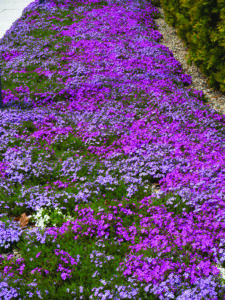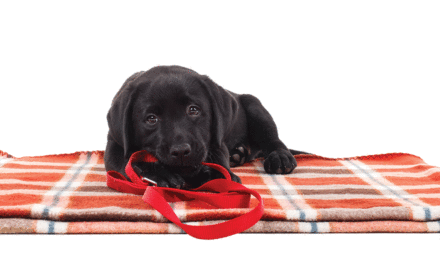
When shopping for low profile options for hard-to-grow places, look for “creeping” plants like Creeping Phlox.
We’ve all heard those insurance commercials– “Are you covered?” or, “Are you in good hands?” As we head toward spring, is your lawn covered?
Whether the problem is too much shade, not enough shade poor soil or something else, grass is not the only option to having a lovely yard.
Grass as a lawn cover goes back to the upper crust of Europe. From surrounding castles to the industrialization of cities and all the way to setting the scene for yard games like croquet, a lush green grass quickly crossed the seas to settle into American culture. By the late 1940s, and the dawn of “cookie cutter” subdivisions, uniform ultra-green grass became not only a status symbol, but an expectation to be an acceptable home.
But in cases where grass won’t grow or if you’re looking to reduce the amount of mowing chores, there are many good options.
When shopping for low profile options, look for “creeping” plants. Creeping Phlox, Blue Star Creeper, and Creeping Jenny are all good bets. Another good designation to look for is “carpet,” which includes Silver Carpet, Red Carpet, and more.
Many options of ground cover can add more than just green on your lawn, they can also add some flower power. You may already have Sedum in your flowerbeds, but there are also creeping varieties in pinks, yellows, purples and more. For flowers in the spring, implement Sweet Woodruff has white flowers and Lamium has purple flowers. Dwarf Nasturtium on the other hand, flowers in the summer and fall. Some types like Creeping Phlox appear more as a lush floral carpet than as turning a bare spot green.
Herbs are another option, especially for smaller areas. Oregano and Thyme both come in a petite creeping variety that can work well for adding in green alone or in garden beds.
While creeping plants may be just right to fill in where grass won’t grow, some could do too good of a job.
An evergreen perennial, Periwinkle or vinca minor is pretty popular as it’s namesake blue and purple flowers serve as a pop of green in the fall and winter, but it’s considered to be invasive by many groups. It’s a similar story for Blue Star Creeper named for its small blue flowers and low growing height and Bishop’s Weed, also called “Snow on the Mountain,” which has 3-inch dark green leaves with white edges.
They’re all available to buy but can easily get out of hand if not kept in check with edging, weeding or herbicide.
Your yard might already be pushing back on your idea of grass with it’s own idea of moss. Areas you have that are super shady as well as consistently moist like near a stream or water, you may notice that moss is already taking over. Moss serves as another ground cover in this climate so rather than trying to remove it, you could embrace it. It can also handle a bit of traffic, so don’t worry about little rainboots out on a frog catching mission running atop. If moss hasn’t made itself at home already you could also look at a “Sheet Moss” variety to get started.
There are also moss varieties that don’t need to be in shade, like Bryum caespiticium, which is known as “sidewalk moss.” This type is great in sunny areas for pops of green without growing over.
While there’s a stage of life that you may want lots of green in your yard for soccer games and the like, there’s also a time you may get more fulfillment out of watching pollinators flutter around. How much of your lawn is used for activities? While an entire lot of wildflowers can be a bold statement, they could be an option for some of the more unused portions.
An important consideration is foot traffic – of all kinds. Kids, dogs and anything else that runs around your yard. Certainly, sports and games are a consideration, but maybe you cut through a certain path to get to the mailbox, or have birdfeeders positioned in optimal viewing spots.
If it’s somewhere you’d like to redirect people from cutting across you could select something taller and more decorative as a deterrent. (It may have been how your grass problem began!) If you review these spaces and find foot traffic is inevitable, pick a variety that is also hearty with a low profile.
If you have a space that doesn’t get much traffic, you don’t need to keep a low profile.
University of Maryland Extension suggests Maryland native switchgrass (Panicum virgatum), little blue stem (Schizachyrium scoparium), and yellow indiangrass as top contenders for taller options.
Going back to the wildflowers idea for spaces with no traffic or severe shade, adding in taller pollinator favorites like Wild geranium, mountain mints, butterfly weed, New England aster, Eastern columbine, cardinal flower and coral honeysuckle. University of Maryland Extension also suggests American holly, inkberry holly, gray dogwood and black cherry to attract songbirds.
If you can only convert a small portion of your yard from standard grass to wildflowers, you’ll still have a yard of beauty that’s also helping wildlife along.
Bare spots in existing garden beds are also good candidates for ground cover.
Instead of mulch between plants and flowers, ground covers can also fill in all the spaces to make your beds look lush and help trap in moisture.
Oftentimes with new builds and remodels, you might have a sliding door that, for now — or until lumber goes down– dumps you right out into the yard and still has traffic coming in and out. And, boy, when it rains, it’s the first place to become a soupy mess.
To protect your house at both its foundation and your kitchen floor, you could do well with pebble rocks or pavers, with compliments of creeping plants bordering or in between them.
Covering tough-to-grow spots can also help prevent mosquitos in low lying areas. Protect your low-lying areas from pooling up with plants to absorb extra rainwater.
The coverage will also help prevent your other plants and trees from getting swamped.




